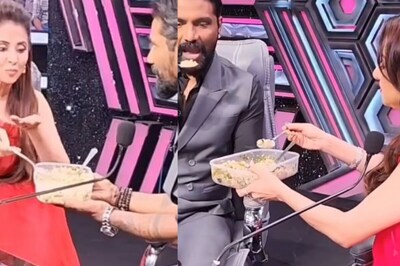
views
Causes and Fixes for a Toilet that Won’t Flush
Closed water inlet valve The inlet valve supplies water to your toilet tank. Professional plumber David Balkan notes that the water valve for a toilet is usually on the wall near the floor. If you accidentally turn the valve and shut off the water supply, your toilet tank won’t fill up and you won’t be able to flush your toilet. Other Symptoms: Empty toilet tank and no water running after you flush your toilet The Fix: Turn the valve to the left by a quarter-turn to open it completely, and listen for water refilling your tank. If the supply line is leaking, then replace it. If the inlet valve is turned on and there’s still no water, test another faucet in your bathroom. If your sink or tub also doesn’t work, then there may be an issue with your home’s main water supply line.
Disconnected flush lever The flush lever connects the handle on the outside of the tank to the rubber flapper at the bottom. If the lever doesn’t move properly, then it won’t be able to lift up the flapper to flush your toilet. Other Symptoms: Loose nut on the flush handle, loose or tight handle, or a broken flush arm inside the toilet tank The Fix: Take the lid off your toilet and turn the nut on the back of the flush handle counterclockwise to tighten it. If the lever arm assembly is cracked or broken, replace the handle assembly with parts that match the size of your toilet.
Damaged float The float is part of your toilet’s fill valve, and it normally stops the water level before it gets too high in the tank. If the float is bent, obstructed, or broken, then it may stop filling the tank before it reaches the proper fill line and result in a weak flush. Other Symptoms: Low water levels in your tank or toilet bowl or loose toilet handle The Fix: Take the lid off of your toilet and check the float, which either looks like a rubber balloon or a plastic cylinder on the fill valve. Bend the arm or use the adjustment screw to raise the float and increase the water level. If there’s damage, then replace the float or fill valve.
Loose lift chain The lift chain connects the toilet handle to the rubber flapper at the bottom of your toilet tank. Patrick Johns, a home improvement specialist, says that if there’s an obstruction or if the chain has too much slack, the flapper won’t lift up all the way and could prevent your toilet from flushing. Other Symptoms: Loose toilet handle or holding down the handle for a long time to flush your toilet The Fix: Take the lid off your toilet tank and locate the chain running from the handle to the flapper. Hook the chain to a different hole on the flush handle arm, or attach it to a lower chain link.
Old or broken flapper The flapper is the round rubber piece at the bottom of your toilet tank. When the flapper starts to wear away or gets coated in residue, then it may not stay up when you flush your toilet. If the flapper drops back down too quickly, then it won’t let enough water into the toilet bowl to flush properly. Other Symptoms: Having to hold down the toilet handle to flush completely or hearing water constantly running into the bowl The Fix: Take the lid off your toilet and inspect the flapper for damage. If the flapper is cracked or covered in residue, then replace it with a new one that matches the size of your toilet.
Low tank water level Professional plumber James Schuelke notes that if the water level in the tank isn’t at the highest setting, then there may not be enough to completely flush your toilet. Other Symptoms: Low water levels in your toilet bowl, or a damaged float or fill valve The Fix: Take the lid off of your toilet tank and look for a mark on the side of the tank or on the toilet’s fill valve. Adjust the fill valve to raise the water to the proper fill line. If you notice water leaking from the tank, then there may be an issue with one of the tank’s rubber seals. Drain your toilet tank and replace any damaged seals you find.
Blocked rim jets The rim jets are the small holes around the toilet bowl’s rim. Schuelke notes that if residue and calcification builds up around these ports, then it can restrict the water flow and prevent your toilet from flushing fully. Other Symptoms: White buildup around the edge of your toilet bowl or water flowing straight down instead of at an angle The Fix: Put on a rubber glove and try to clean the ports with your fingers or a small cleaning brush. Schuelke also mentions that adding dish soap to the toilet tank and flushing your toilet is a good hands-free approach to cleaning the ports.
Clogged drain pipes The most common reason your toilet won’t flush is debris or waste caught in the pipes. The blockage could be inside of your toilet’s trap, or it may have moved further down your pipes. Other Symptoms: Toilet overflowing or water level that won’t go down The Fix: Unclog your toilet with a plunger, snake, or other DIY method.
How to Unclog a Toilet
Use a plunger to force the clog down your pipes. Make sure you use a plunger made for toilets so it fits in the bowl correctly. Place the plunger in your toilet bowl so the cup fits completely around the hole in the bottom. Quickly move the handle straight up and down for about 20 seconds to help move the clog. Lift your plunger and let the water drain before trying to flush your toilet again. If your toilet bowl is already filled with water, use a bucket to bail about half of the water out so it doesn’t overflow while you’re plunging.
Add dish soap to your toilet bowl to dissolve the blockage. Start by pouring about 1 cup (240 ml) of liquid dish soap into your toilet bowl and let it sit for about 60-90 minutes. The soap will help break apart the clog so it slips through your pipes easier. After that, pour a pot of hot water down the drain and try flushing your toilet. Any liquid dish soap will work, but try using ones that are labeled extra strength for extra grease-fighting power. Avoid using boiling water because it could cause your toilet bowl to crack.
Break apart the clog with your toilet brush. If you need to unclog your toilet without a plunger, Schuelke recommends using the toilet brush you use to clean. He says to place the brush head into the hole at the bottom of the toilet and quickly move it up and down like a plunger.
Try a baking soda and vinegar mix to loosen the clog. Sprinkle about 1 cup (272 g) of baking soda directly into your toilet bowl. Slowly add 1–2 cups (240–470 ml) of distilled white vinegar to the bowl so it doesn’t overflow. Leave the baking soda and vinegar for about 30 minutes. Then, pour a pot or bucket of hot water directly into the toilet bowl to push the clog out from the pipes. If you start pouring hot water but the water level keeps rising, then stop and try another method for removing the clog.
Snake the toilet drain for removing deeper clogs. When you can’t reach a clog with other techniques, push the end of a drain snake into the bottom of your toilet bowl. Slowly extend the snake further into the drain until you hit a blockage. Once you feel it, turn the snake’s handle and gently push it further to break apart the clog. Once it’s clear, pull the end of the snake back out and slowly remove it from your toilet. Avoid pulling out the snake while it’s extended because you could scratch or damage your toilet bowl. If you don’t have a drain snake, then unbend an old wire hanger and wrap the end with an old dishcloth so you don’t scratch your toilet bowl.
FAQ
How do you fix a push button toilet that won’t flush? Many times, a push button or dual flush toilet that doesn’t flush has an issue with the fill valve not refilling the tank. Take the lid off of the tank and inspect the fill valve and float to see if it’s damaged or not working. If it doesn’t work, replace the fill valve. If you’re having an issue with the buttons not pressing down correctly, then replace the flush mechanism in the center of the toilet tank.
Why does my toilet not fill with water after flushing? Your toilet may not fill with water if the inlet valve on the wall is turned off, so try turning it counter-clockwise to put it back on. If the toilet still doesn’t fill, then there may be an issue with the flush valve or float inside the tank. If your toilet tank doesn’t fill with water but you hear water running, then the issue may be a loose or damaged flapper at the bottom of the toilet tank.
How do you manually flush a toilet? If your toilet doesn’t have any water in the tank but you need to flush, fill a large bucket with about 1 US gal (3.8 L) of water. Slowly pour the water directly into your toilet bowl. The water forces what’s in the bowl to move through the pipes.
How do I know if my toilet needs to be replaced? Even if you take care of your toilet, the mechanical parts will start to wear out as they get older. If you notice your toilet is clogging more than once a week, has running water that won’t stop, or if you find a crack in the bowl or tank, then it’s time to replace the toilet.
When should I contact a plumber to fix my toilet? If none of the other fixes have worked and your toilet is still not flushing properly, then there may be a clog deep in your pipes or another larger issue. Reach out to multiple plumbers to check their rates and have one come check out the problem.




















Comments
0 comment